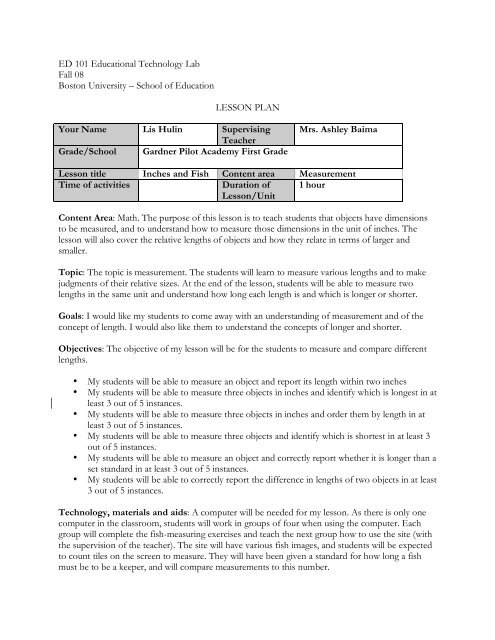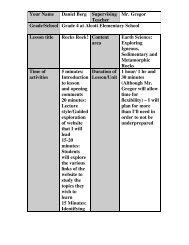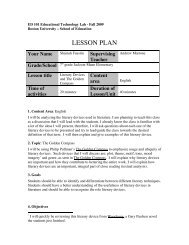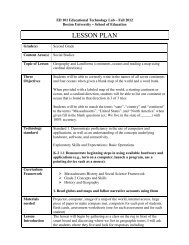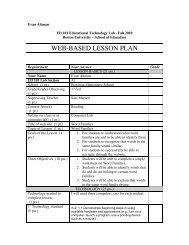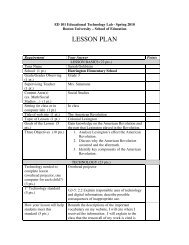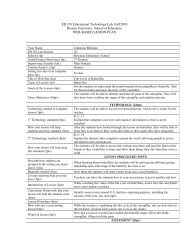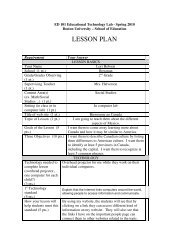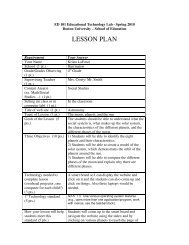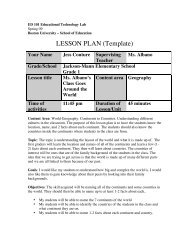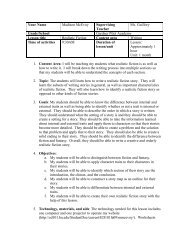Lesson Plan - ED101 - Boston University
Lesson Plan - ED101 - Boston University
Lesson Plan - ED101 - Boston University
Create successful ePaper yourself
Turn your PDF publications into a flip-book with our unique Google optimized e-Paper software.
ED 101 Educational Technology LabFall 08<strong>Boston</strong> <strong>University</strong> – School of EducationLESSON PLANYour Name Lis Hulin SupervisingTeacherGrade/School Gardner Pilot Academy First GradeMrs. Ashley Baima<strong>Lesson</strong> title Inches and Fish Content area MeasurementTime of activitiesDuration of 1 hour<strong>Lesson</strong>/UnitContent Area: Math. The purpose of this lesson is to teach students that objects have dimensionsto be measured, and to understand how to measure those dimensions in the unit of inches. Thelesson will also cover the relative lengths of objects and how they relate in terms of larger andsmaller.Topic: The topic is measurement. The students will learn to measure various lengths and to makejudgments of their relative sizes. At the end of the lesson, students will be able to measure twolengths in the same unit and understand how long each length is and which is longer or shorter.Goals: I would like my students to come away with an understanding of measurement and of theconcept of length. I would also like them to understand the concepts of longer and shorter.Objectives: The objective of my lesson will be for the students to measure and compare differentlengths.• My students will be able to measure an object and report its length within two inches• My students will be able to measure three objects in inches and identify which is longest in atleast 3 out of 5 instances.• My students will be able to measure three objects in inches and order them by length in atleast 3 out of 5 instances.• My students will be able to measure three objects and identify which is shortest in at least 3out of 5 instances.• My students will be able to measure an object and correctly report whether it is longer than aset standard in at least 3 out of 5 instances.• My students will be able to correctly report the difference in lengths of two objects in at least3 out of 5 instances.Technology, materials and aids: A computer will be needed for my lesson. As there is only onecomputer in the classroom, students will work in groups of four when using the computer. Eachgroup will complete the fish-measuring exercises and teach the next group how to use the site (withthe supervision of the teacher). The site will have various fish images, and students will be expectedto count tiles on the screen to measure. They will have been given a standard for how long a fishmust be to be a keeper, and will compare measurements to this number.
Procedures/methods:a. Overview: First the teacher will explain the concept of measurement and why it isuseful. Students will draw pictures of fish and measure each other’s fish. While the largegroup is working on this project, the students will use the computer three at a time (asthere are three fish to measure on the website) and work together to complete the quizwith the supervision of the teacher or an aide.b. Introduction: The lesson will begin with an explanation of measurement and why weneed it. The teacher will then explain the activities and demonstrate the use of the sitefor the children.c. Activities:• The 15 children will be split into five groups of three.o Each group will be given fish worksheets (see attached worksheet A) andpencils• Groups are informed that they have ten minutes to each draw three fish.o Students are also told that they will have ten minutes to measure each fishusing inch tiles and to write their measurement on the worksheet.• After the children have drawn their fish, the first group moves to the computerswhile the other children each pick a fish drawing to measure.o Each student gives one fish drawing to each other student in the group.• After ten minutes, the second group moves to the computers and the first groupbegins measuring their first fish.• Three more changes allow all the groups a chance at the computers and at measuringeach others’ fish.o During each rotation, teacher and aides should discuss the activities with thestudents to informally check whether the objectives noted above are beingfulfilled.• For the final ten minutes, hand out worksheet B and have students complete it.d. Follow-up: Hand out homework sheets (worksheet C) and paper rulers. Students mustmeasure three objects in their home and return the worksheet the next day.e. Assessment: Students will be assessed based on their completion of the two in-classworksheets and a homework sheet (see worksheets A-C) and the five-question webbasedquiz below:f.Question 1: A flounder must be 9 inches long to be a keeper. Miguel's flounder is 12inches long. Is it a keeper?a. Yesb. NoQuestion 2: David caught 3 carp. His first fish is 5 inches long. His second fish is 8inches long. His third fish is 6 inches long. Which fish is the longest?a. 5 inch fishb. 8 inch fishc. 6 inch fishQuestion 3: Natalie caught a grilse. It is 8 inches long. To be a keeper, it must be 10inches long. How much longer does this fish have to be to be a keeper?
a. 2 inches longerb. 3 inches longerc. 4 inches longerQuestion 4: Jude caught a flounder. It is 13 inches long. To be a keeper, it must be 9inches long. How much shorter could it be and still be a keeper?a. 1 inch shorterb. 3 inches shorterc. 4 inches shorterQuestion 5: Genesis caught a fish. It is 8 inches long. It is a keeper! To be a keeper,a flounder must be 9 inches long, a carp must be 7 inches long, and a grilse must be10 inches long. Which kind of fish is it?a. flounderb. carpc. grilse• Technology Frameworks:1.9 Explain that the Internet links computers around the world, allowing people to accessinformation and communicate.2.1 Follow the classroom rules for the responsible use of computers, peripheraldevices, and resources.2.3 Explain why there are rules for using technology at home and at school.
Worksheet A:
Worksheet B:
Worksheet C:


